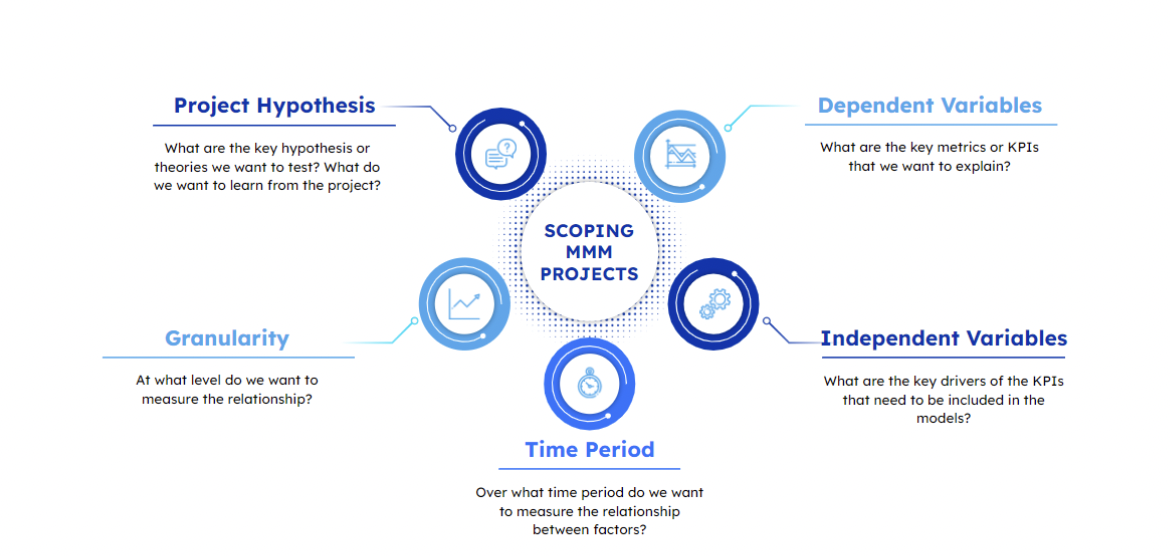Marketing Mix Modeling (MMM) serves as the “compass” guiding businesses in optimizing their marketing strategies. Through MMM, businesses can dissect each marketing element such as advertising, promotions, and pricing to identify the key factors that drive sales. By combining historical data with intelligent algorithms, MMM not only helps businesses make more effective marketing investment decisions but also significantly reduces costs. In this article, PMAX explores the 4-phase implementation process of Marketing Mix Modeling.
Phase 1: Define the Project Scope
The first phase in implementing Marketing Mix Modeling (MMM) is “Defining the Project Scope.” This is a crucial stage as it lays the foundation for the entire project, ensuring that business objectives and analytical requirements are clear and precise. Key questions to address during this phase include:
- What is the business problem to be solved? This helps set the primary goal of the MMM project, such as increasing sales, optimizing marketing costs, or improving campaign effectiveness.
- What is the dependent variable? This is the key metric the business wants to optimize or explain, which could be sales, the number of orders, new customers, app installs, or any other critical business indicator.
- What are the independent variables? These are factors that might influence the dependent variable, including marketing spend across different channels, types of promotions, and various marketing activities. Deep market and industry expertise is necessary to identify all relevant independent variables.
- What is the data collection and measurement period? Clearly defining this timeframe ensures comprehensive and accurate data collection, reflecting true changes and trends in business activities.
- What is the granularity of each variable? This involves breaking down variables for detailed analysis, such as separating advertising costs on Facebook by different objectives like branding and performance.

Factors to determine when conducting a Marketing Mix Modeling (MMM) project – source: PMAX
Addressing these questions helps define the project’s scope and objectives, ensuring all important factors are comprehensively and accurately analyzed.
Phase 2: Data Selection & Review
Data Collection & Consolidation
The process begins with gathering data from various sources, including marketing expenses, sales figures, profits, and other factors like market conditions, economic indicators, and competitive factors. This data is typically sourced from customer relationship management (CRM) systems, enterprise resource planning (ERP) systems, online advertising platforms, market research services, and external data sources.
Data Cleaning & Preprocessing
Collected data often needs to be cleaned and preprocessed to remove outliers, missing values, or errors. Preprocessing steps include filling in missing values, eliminating duplicate data, ensuring consistency, and standardizing the data to maintain accuracy and reliability.
Phase 3: Model Building & Validation
Model Building
This is the core phase of the project, where the prepared data is used to develop statistical models:
- Choosing the modeling method: Decide on the statistical or machine learning method to build the model. Common methods include linear regression, nonlinear regression, decision trees, support vector machines (SVM), and neural networks. The choice depends on the data characteristics and analytical goals.
- Building the model: Use the prepared data to construct the model, selecting appropriate variables, setting initial parameters, and training the model. The goal is to accurately and comprehensively explain the relationship between independent and dependent variables.
- Optimizing the model: Adjust parameters and variables to optimize model performance. This might involve adding or removing variables, adjusting regression coefficients, or using other optimization techniques to improve accuracy and predictive power.
Model Validation
A critical step in model building is validating its accuracy and reliability. This involves testing the model on independent datasets, comparing predictions to actual data, and checking model stability over time. This ensures the model is not overfitted and can generalize well to new data. Key metrics for evaluation include R-squared, Mean Absolute Error (MAE), and Root Mean Squared Error (RMSE).
Phase 4: Insights & Recommendations
Insights Extraction
After building and validating the model, detailed analyses are conducted to understand how marketing variables impact sales and profits. Key factors and their influence levels are identified and provided to marketers.
Recommendation Generation
Based on MMM analysis, recommendations are made to improve marketing performance and optimize budget allocation. Managers can use these insights to adjust their marketing strategies and achieve business goals.
Conclusion
Implementing Marketing Mix Modeling (MMM) is a complex but highly valuable process, helping businesses gain deeper insights into their marketing activities and make strategic decisions. From defining the project scope, selecting and reviewing data, to building and validating models, each phase requires meticulous attention and professionalism. When done correctly, MMM not only offers insights into the impact of marketing factors but also optimizes costs and enhances business performance.
Currently, PMAX – Total Performance Marketing Agency, is a pioneer in providing Marketing Mix Modeling (MMM) services to businesses in Vietnam. Committed to delivering effective measurement solutions and optimal marketing strategies, PMAX uses the Robyn model – an advanced AI model developed by Meta Marketing Science specifically for MMM.
If you want to learn how Marketing Mix Modeling (MMM) can enhance the effectiveness of your marketing campaigns, contact PMAX today and don’t miss PMAX’s Ebook on Marketing Mix Modeling here.
